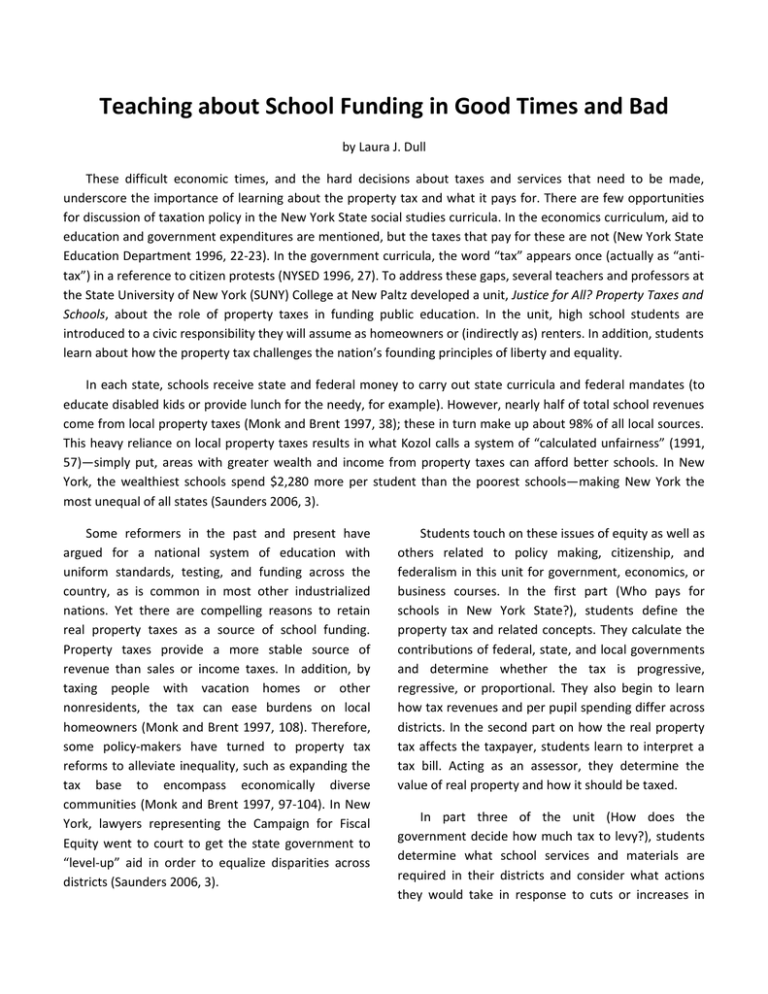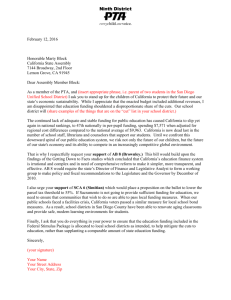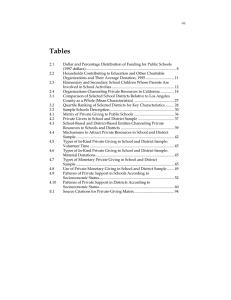Teaching about School Funding in Good Times and Bad
advertisement

Teaching about School Funding in Good Times and Bad by Laura J. Dull These difficult economic times, and the hard decisions about taxes and services that need to be made, underscore the importance of learning about the property tax and what it pays for. There are few opportunities for discussion of taxation policy in the New York State social studies curricula. In the economics curriculum, aid to education and government expenditures are mentioned, but the taxes that pay for these are not (New York State Education Department 1996, 22-23). In the government curricula, the word “tax” appears once (actually as “antitax”) in a reference to citizen protests (NYSED 1996, 27). To address these gaps, several teachers and professors at the State University of New York (SUNY) College at New Paltz developed a unit, Justice for All? Property Taxes and Schools, about the role of property taxes in funding public education. In the unit, high school students are introduced to a civic responsibility they will assume as homeowners or (indirectly as) renters. In addition, students learn about how the property tax challenges the nation’s founding principles of liberty and equality. In each state, schools receive state and federal money to carry out state curricula and federal mandates (to educate disabled kids or provide lunch for the needy, for example). However, nearly half of total school revenues come from local property taxes (Monk and Brent 1997, 38); these in turn make up about 98% of all local sources. This heavy reliance on local property taxes results in what Kozol calls a system of “calculated unfairness” (1991, 57)—simply put, areas with greater wealth and income from property taxes can afford better schools. In New York, the wealthiest schools spend $2,280 more per student than the poorest schools—making New York the most unequal of all states (Saunders 2006, 3). Some reformers in the past and present have argued for a national system of education with uniform standards, testing, and funding across the country, as is common in most other industrialized nations. Yet there are compelling reasons to retain real property taxes as a source of school funding. Property taxes provide a more stable source of revenue than sales or income taxes. In addition, by taxing people with vacation homes or other nonresidents, the tax can ease burdens on local homeowners (Monk and Brent 1997, 108). Therefore, some policy-makers have turned to property tax reforms to alleviate inequality, such as expanding the tax base to encompass economically diverse communities (Monk and Brent 1997, 97-104). In New York, lawyers representing the Campaign for Fiscal Equity went to court to get the state government to “level-up” aid in order to equalize disparities across districts (Saunders 2006, 3). Students touch on these issues of equity as well as others related to policy making, citizenship, and federalism in this unit for government, economics, or business courses. In the first part (Who pays for schools in New York State?), students define the property tax and related concepts. They calculate the contributions of federal, state, and local governments and determine whether the tax is progressive, regressive, or proportional. They also begin to learn how tax revenues and per pupil spending differ across districts. In the second part on how the real property tax affects the taxpayer, students learn to interpret a tax bill. Acting as an assessor, they determine the value of real property and how it should be taxed. In part three of the unit (How does the government decide how much tax to levy?), students determine what school services and materials are required in their districts and consider what actions they would take in response to cuts or increases in state and federal funding. In part four (Does reliance on the property tax contribute to inequities in the quality of schooling?), students use Internet resources to compare their district with a low-, medium- and high-income school districts. They must determine what factors determine school quality and then hypothesize on whether or not the property tax contributes to the inequalities they find across districts. In the final section, students look at alternative models for property taxation and present their recommendations for property tax reform to their classmates. By touching on issues of public school financing, citizenship and its responsibilities, federalism, and the meanings of liberty and equality (see state and national standards), this curriculum is appropriate for high school civics/government, economics, business, and finance courses. It can also be adopted for use in introductory economics and government courses at community colleges or four-year institutions. Each part of the unit could stand alone, but all 14 lessons will facilitate deeper understandings of educational equity and quality and their relation to school funding. The curriculum is divided into five units that are best taught as a whole, but can also be taught as single units. In Part 1, “Who pays for schools in New York State?”, students define the property tax and related concepts such as equalization rates. They calculate the contributions of federal, state, and local governments and determine whether the tax is progressive, regressive, or proportional. They also begin to learn about how tax revenues and per pupil spending differ across districts. In the second part, “How does the real property tax affect the taxpayer?”, students learn to interpret a tax bill. Acting as an assessor, they determine the value of real property and how it should be taxed. In part three, “How does the government decide how much tax to levy?”, students act as local school and government officials to determine what school services and materials they would fund. In addition, they consider actions they would take in response to hypothetical increases or cuts in state and federal funding. In part four, “Does reliance on the property tax contribute to inequities in the availability of quality education for students in New York State?”, students use internet resources to compare their district with a low-, medium- and high-income school district. They must determine what factors determine school quality and then hypothesize on whether or not the property tax contributes to the inequalities they find across districts. In the final section of the unit, “Should we reform the property tax in New York State?,” students look at alternative models for property taxation and present their recommendations for property tax reform in New York State to their classmates. The entire unit is available online at http://www2.newpaltz.edu /~dullj/lincoln/. References Kozol, J. 1991. Savage Inequalities: Children in American Schools. New York: Crown. Monk, D. and Brent, B. 1997. Raising Money for Education: A Guide to the Property Tax. Thousand Oaks, CA: Corwin Press. New York State Education Department. 1996. Learning Standards for Social Studies. Albany, NY. Saunders, S. 2006, January 3. “State’s Funding Gap Yawns Wide for Poor Kids,” New York Teacher, 19. What should we do if the federal or state government cuts our aid? Note: This lesson is the third lesson in Part Three of the unit so the teacher will need to provide some background information on how schools are funded. Opening Activity: Have student pairs discuss their homework (Handout: The Consequences of Budget Cuts) and decide which options are best. Some actions they might consider would be raising property taxes or cutting programs. Activity: Announce: “Today we will run a school board meeting to decide what the Board of Education (BOE) should do in response to the cut in state (or federal) aid.” Assign students the following roles: 1 will be the Superintendent 1 will be the BOE President 4 will be “Pro-Cutting the Budget” Board Members 4 will be “Pro-Increasing Local Revenue (Property Tax)” Board Members Others will be community members, including senior citizens, students, union representatives, teachers, parents of current students, and parents of students involved in extra-curricular activities (band, athletics, choir, etc.) Have the BOE President call the special meeting to order. Have the board members discuss the issue. Allow time for public comment. At the close of the discussion, have the board vote on the appropriate action to take. Note: Teachers might want to invite a community board member to this hearing. Discuss: Do you agree or disagree with the decision made by the Board of Education? What might be the implications and consequences of their action? Explain your opinion. Homework: Reflect on the activity today. What did you learn about school funding? Did you agree or disagree with the decisions made? Variation: This meeting could also be conducted to discuss actions the board would take if school funds were increased by the state or federal governments. Join the New Jersey Council for the Social Studies (Photocopy this form or print information from http://www.njcss.org) Name: _______________________________ Address: _____________________________________________________ City: ____________________________ State:______ 9-Digit Zip: _____________ Home Phone ( ) _____ __________ School Name and Address: _____________________________________________________________ County _______ City: ____________________________ State:______ 9-Digit Zip: __________ E-Mail __________________________ Level: __ Elementary __ Middle/Junior High __ Secondary/Senior High __ College/University __ General Title: __ Teacher __ Chairperson __ Supervisor __ Education Dept./Association ___ Agency/Society ___ Publisher Rep __ Consultant ___ Student/Student Teacher ___ Retired ___ Other ____________________________________ Dues: ___ 1 year ($25.00) ___ 2 years ($40.00) ___ Retired ($10.00) ___ Student ($10.00) ___ Renewal ___ New Amount Enclosed $_______ Instructor’s Signature Required for Student Membership _______________________________ Return to: NJCSS c/o NJCCLRE, Rutgers University, Lucy Stone Hall (B303), Piscataway, NJ 08854 (Check or money order only. No purchase orders.)




